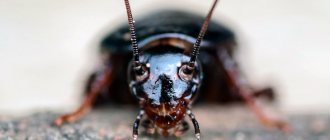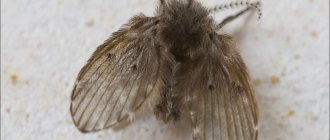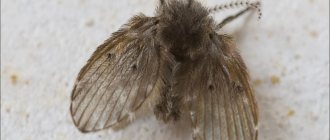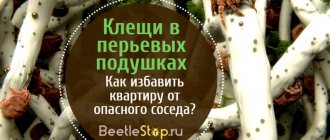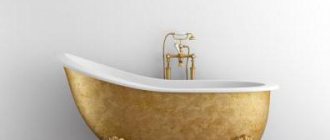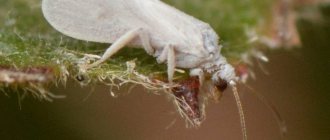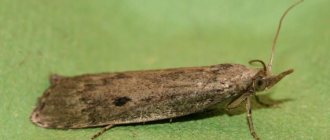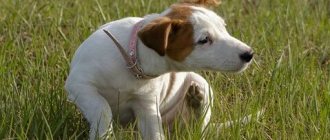A variety of insects often settle in the vicinity of humans, which sometimes cause inconvenience. Some of them are completely harmless to people and animals, while some, on the contrary, are extremely dangerous parasites. One of these insects are hay eaters, or as they are also called “book lice.” They are quite rare insects. However, their appearance in an apartment or house can bring a lot of negative emotions and harm to a person.
An invasion of hay beetles is an unpleasant “surprise” for home owners. After all, they may not even know where these insects came from. In any case, everyone wants to get rid of book lice as quickly as possible so that they do not bother them. We will tell you in what ways this can be done in this article.
Description of hay beetles, their eating habits and reasons for their appearance in the home
Hay eaters are widespread in the wild. This is their natural habitat. Bugs live in grass, bushes and trees. This type of insect can feed on plant foods and sometimes the remains of dead animals.
Book lice differ from ordinary lice in many ways. The size of domestic hay beetles is 2 millimeters, while the size of other lice and bedbugs is 4-6 millimeters. The color of hay eaters can vary from pale white to dirty yellow. These insects do not bite people or pets, whereas regular lice do so for their nutrition.
When settling in apartments, book lice feed on paste. It is because of this that their name actually arose. Previously, back in Soviet times, book spines were used to prepare paste. That is why hay eaters can often be found between the pages of old books.
Today, such pastes are no longer produced and therefore book lice do not live in all books. They live only in libraries or in the homes of people who collect old publications. Despite this, this type of insect easily adapts to any conditions of residential apartments and houses, finding food for itself there.
Senoyeds can also be found in the so-called “Stalinka” buildings. The fact is that in such houses there are traces of wallpaper glue, which these insects love so much. In addition, fungus is common in “Stalinkas”, which serves as a favorable condition for the proliferation of lice. In addition to mold and paste, hay beetles can also feed on other remains of organic elements. Their rapid reproduction is also influenced by warm air in the room and increased humidity levels.
In many cases, book lice choose as victims the owners of the upper floors, as well as the owners of private houses with leaking roofs.
What lice look like: appearance, photo under a microscope and description
However, pediculosis is a common disease even in our fairly prosperous times. It affects not only people leading an asocial lifestyle. Anyone can become infected: in public transport, at a mass event, in a bathhouse or swimming pool, in a hotel or sleeping car. Children “bring lice” from kindergarten, school, or summer health camp.
To “know the enemy by sight,” look at what human lice look like in the photo.
This is a very small insect with three pairs of prehensile legs. Its body is almost transparent, and can be seen changing color from grayish to purple when the parasite drinks blood. The louse navigates in space by odors, which it perceives with short antennae located on the head. A louse's eyes are useless - they're just pigment spots.
Specifics of the appearance of hay beetles in apartments and houses
Often insects such as book lice settle in the pipes of the garbage disposal and heating system. In an apartment or house, they can sit comfortably in the kitchen cupboard, eating dry cereals and pasta. It is also worth remembering that if you have old Soviet-era literature at home, then in 95% of cases these insects have already made it their refuge.
It is surprising and at the same time scary that book lice can produce offspring without direct fertilization. Their females can lay from 25 to 60 eggs during the day.
It is for this reason that owners of houses and apartments must keep their homes clean. After all, dirt, dust, and crumbs contribute to the appearance of hay beetles and their rapid reproduction.
Bed louse propagation methods
The insect has enormous fertility. is capable of laying from 5 to 14 nits per day . Thanks to the special mucus secreted by the female, the egg is firmly attached to the fibers of the material until it is fully matured.
The lifespan of one individual is 35 days. During this time, she manages to lay off 200 to 400 nits. The growth of eggs and the maturation of louse larvae occurs due to the parasitic lifestyle on the human body.
As soon as the insects sense the warmth and odor of the body, they begin their activity. Spreading over the body, they choose the most suitable place, pierce the skin with a special proboscis and suck out the amount of blood necessary for further existence. Their color changes from pale gray to bright brown and even brown.
The bed louse is a very tenacious insect . In the absence of a human body and, accordingly, food, they easily survive up to one week. Finding themselves, even after such a long period of time, in an environment favorable to themselves, they quickly restore their strength and continue their parasitic way of existence.
But, after 5-7 days, without access to the human body, the body louse quickly dies. That is why most often this type of insect lives on a contingent of people who are deprived of the opportunity to frequently change clothes and linen: refugees, soldiers in the field, beggars or tramps.
Peculiarities of book lice reproduction
Hay eaters can lay either 1 or several eggs at a time. On average, they produce up to 40 eggs in one day. The maximum number they can lay in 24 hours is 60 eggs.
Almost all eggs hatch into larvae in 99% of cases. The lifespan of an adult is related to its habitat: temperature, humidity and food availability. In the right conditions, healthy insects can live up to 53 weeks. However, even if there is no food, hay beetles can live indoors for quite a long time without it.
Habitats
The order of hay beetles includes almost 1,000 insects of different species that live in different climatic zones around the world. Extensive areas infested by these insects are found in tropical and subtropical areas with high air humidity.
Dusty hay beetles (Troctes divinatorius) mostly live near humans or animals.
Small parasites actively breed in libraries, doghouses, bird nests, rodent burrows, haystacks and grain warehouses. They can be found in damp and cluttered rooms and damp basements. They eat mold, starchy substances and plant waste.
These bugs are rarely found in new buildings, more often in old houses and abandoned premises. They can be found in apartments where wallpaper was glued with flour paste. These are mainly old “Khrushchev” and “Stalin” buildings, in which older people live.
A detachment of hay eaters is actively breeding in libraries.
Entomologists consider temperatures of +16…+32°C and humidity above 55% to be a favorable environment for the reproduction of pests. Therefore, it is most difficult to remove hay beetles in the bathroom.
Key dangers of book lice
The main danger of hay beetles for human health is the occurrence of an allergic reaction of varying severity from touching the insect or from contact with the place where it has been.
In many cases, such allergic manifestations are not dangerous for people and are usually mild. However, sometimes without proper assistance, a person may develop Quincke's edema, which threatens to suffocate.
Sometimes hay eaters can scare children and even adults. For some who suffer from entomophobia (fear of insects), lice can cause serious inconvenience and problems.
As a rule, the population of England, as well as some other European countries, suffers from book lice.
How to avoid getting pediculosis
The cause of the disease is always the same - contact with a sick person.
From this reason, as well as from some features of the development of lice, preventive measures follow:
- Do not have close contact with an infected person if you know they are sick.
- Avoid close contact in crowded places.
- Do not try on other people's hats or other clothes; use only your own hairpins, comb, headband, and headphones. Teach your children to do the same.
- In a shared wardrobe, leave your hat and scarf only in a separate bag.
- Inspect each other carefully when returning from crowded places. Periodically examine children attending school or kindergarten. Don't forget about the inspection when your child returns from a children's health camp.
- Change bedding and underwear at least once every 7-10 days.
- When traveling, carefully inspect bedding in trains, hotels, boarding houses, etc. before use.
- Use a cap in the pool.
- Iron clothes after washing and drying.
- If you find single lice that have not yet laid eggs, you can simply comb them out with a fine-toothed comb. If body lice are found in equally small numbers, boil your underwear and carefully iron the rest of your clothing.
- If lice have already laid eggs, preventive measures are useless. Buy a complete treatment, for example, Parasept.
- Braid tight braids for girls with long hair.
If there is an outbreak of head lice in a child care facility that a child attends, or if one of the family members is infected with lice, it would be a good idea to use a special repellent to repel these insects.
Prevention methods with hay eaters
The dilemma of how to exterminate hay beetles is familiar to residents of Russia. However, fortunately, this problem is not as widespread in our country as, for example, in the UK. Therefore, there are no special methods to combat hay beetles. However, there are tips and tricks to help remove these harmful bugs:
- You should pay special attention to cleanliness and hygiene in your apartment or house - wash the floors every day, wipe the dust off the bookshelves, take out the trash every day.
- If there are flowers and herbariums in the house, it is recommended to frequently wipe off the dust from them.
- It is better not to store old cereals and expired food in the kitchen. They need to be thrown into the trash so that they do not become a source of food for hay eaters.
If there are a lot of book lice in your home, only heavy artillery will help. For example, disinfection of premises, which is carried out using special chemical poisons. Special services can effectively deal with insects using insecticidal preparations. In very advanced cases, treatment with cold or hot fog will help, which will cover the entire area of the apartment or house.
What nits look like: appearance, photo and description
True, all these features of lice can only be seen under a microscope. You will most likely find out that you or your loved ones have lice by other symptoms. The most obvious are itching and nits.
Nits are lice eggs, which the female lays several hundred in her lifetime. It attaches them very firmly to the base of the hair with an adhesive mass.
The louse attaches nits to the hair near the head, where the temperature is optimal for the development of the embryo. If you find them not at the roots, it means that a lot of time has passed since the laying: the hair has grown back, and the larvae have already hatched from the shells.
Nits are drop-shaped, whitish in color, and do not exceed 1 mm in length. They are clearly visible on the hair. But those whose vision is not the sharpest sometimes confuse them with dandruff.
How to distinguish from dandruff
You can see what lice eggs look like on hair in the photo.
It can be seen that even the empty shell of the egg retains its volume. Whereas dandruff is flat scales of the epidermis.
You can tell one from the other without looking closely. Dandruff can be removed from your hair by simply rubbing it with your hand. Nits are firmly glued to the hair: they have to be removed almost one at a time. In addition, lice cause unbearable itching of the head, and together these two symptoms are a sure sign of lice.
In what cases is it necessary to destroy book lice?
In some cases, it does not make sense to treat premises against hay eaters. After all, they are not dangerous to people and animals, do not carry infections, do not bite and do not live in upholstered furniture or bedding, and do not even have a specific smell.
The only thing they can do is scare a person or cause allergies, eat cereals and leftover food, and also spoil book publications.
We can safely say that book lice do not pose a serious danger to humans and their homes. Whether to exterminate them or not is a matter of choice. This issue is decided based on the number of insects and the problems that home owners have because of them.
The book that was ruined by the hay eaters
Characteristics of the parasite
It is almost impossible to distinguish a body louse from a head louse with the naked eye: this is an insect with a characteristically elongated abdomen measuring 3-4 mm. Its chitinous body is grayish-yellow or whitish in color, almost transparent, therefore, when drinking blood, the parasite turns brown. Linen lice look abundantly saturated, almost like fleas, but, unlike the latter, they cannot jump.
With such an obvious similarity between the two varieties, if a linen louse accidentally lands on your head, it will not stay there for long. This is because the insect's legs are not designed to climb hair and lay eggs.
"Shelter" and food
The bed louse feeds on human blood. It feeds every three to four hours, but the insect does not need to constantly be on the body of the “owner”. Therefore, the parasite spends most of its life in the folds, seams and lint of clothing. Lice feel more comfortable in linen and cotton products. They avoid satin and silk: there is nothing to cling to.
The adaptability of parasites is amazing: pests almost never settle on woolen products, since people rarely wear such things on their naked bodies.
Life cycle
The lifespan of a male is a little less than a month, a female is about 45 days. During this time, she manages to lay approximately 100-140 nits (about four eggs per day). The life cycle of an insect can be roughly divided into five stages.
- Egg. The rudiment of a louse, covered with a special sticky substrate, is called a nit. This formation is attached to the fibers of clothing so firmly that it is problematic to remove it mechanically.
- Larva. After three days, a larva emerges from the nit, which outwardly looks like a small adult.
- Nymph of the first instar. The insect drinks blood, after which it immediately molts, changing its chitinous body - now it is a first-instar nymph.
- Nymph of the second age. After five days, the next molt occurs, and the parasite becomes a second instar nymph.
- Adult. After another eight days, the third molt occurs, after which the louse becomes a sexually mature organism capable of reproducing.
The body louse travels from an egg to a sexually mature insect in 16 days under favorable conditions.
Harm
The body louse is a carrier of dangerous diseases: typhus (relapsing and typhus), Volyn fever. During the war, typhus, spread by pests, claimed thousands of lives. In the modern world, the likelihood of such infection is low. The main “trouble” caused by the parasite to humans is the bites of linen lice, the consequences of which are:
- unpleasant sensations - burning, itching;
- danger of infection - through the wound it is easier for pathogenic microorganisms to enter the blood;
- dermatological lesions - in advanced cases, scabs, suppurations, and pyoderma appear on the skin.
On a social level, a person infested with lice also experiences inconvenience, feeling discomfort when interacting with other people. The dermatological symptoms that result from a lice infestation are called body lice.
Where do they come from?
A body louse cannot live without food for more than five to seven days, so if you do not wear clothes that have been “occupied” by insects for at least a week, the adult louse will die. Therefore, by and large, the “carriers” of parasites are representatives of asocial groups and people who neglect the rules of personal hygiene.
However, anyone can accidentally “catch” lice. Infection occurs only through close contact with the tissues on which the parasites live: they cannot fly or jump. The risk group consists of volunteers, medical and social workers, people who come into contact with representatives of antisocial segments of the population. Where else do linen lice come from? You can catch the pest:
- when using someone else's bed linen and clothing;
- in a store fitting room;
- in places where large numbers of people gather;
- in kindergartens and schools.
Linen lice can be detected by two signs: the presence of bites on the body and the presence of the parasites themselves in clothing and bedding.
Folk and chemical methods of exterminating hay eaters
If hay eaters have found refuge in the form of books or things, you can use folk methods of combating these insects:
- Books and any other paper items infested with book lice can be placed in the freezer for 24 hours. It is recommended to first wrap the paper item in a plastic bag. It is not recommended to do this with valuable books and other antique items.
- It is better to wash clothes and textile items with traces of the presence of book lice at maximum temperature. Next they are treated with a steam iron or just an iron.
If the item cannot be washed at high water temperatures, you can add the following chemicals to the washing machine: “Abacteril”, “Forex-Chlor”, “Trilox”, “Purzhavel”, “A-Par”.
Effective Treatments
The main problem of many folk remedies is low efficiency. To achieve results, processing with them must be repeated many times.
Pharmacy products are also not all equally good. Those that act at the chemical level, causing insect paralysis, are also unsafe for humans. But there are compounds that physically destroy parasites without harming the patient at all.
The main component of Parasept is dimethicone. This is a synthetic oil, silicone, which is actively used in the cosmetics industry. It can be found in shampoos, hand and face creams, and decorative cosmetics. The task of dimethicone is to create a thin film on the skin and hair that will protect against external influences and retain moisture inside.
It does roughly the same thing with lice: it covers them with a thin moisture- and air-tight film, clogging the respiratory and excretory organs. As a result, the insect dies from suffocation and excess pressure, unable to get rid of excess fluid in the body.
The main advantages of Parasept over other drugs:
- efficiency;
- safety (use allowed from 1 year);
- convenient aerosol form;
- Insects do not develop resistance (addiction) to the active substance.
Treating your hair with an aerosol can is easy. The composition is sprayed into tiny particles, completely covering every hair and every parasite.
After two weeks, the treatment should be repeated.
Insecticidal preparations for controlling hay beetles at home
If you decide to destroy book lice in your home yourself, the following insecticidal preparations for crawling insects are ideal for this purpose:
- “Clean House Super” is universal;
- “Raptor” is universal;
- “Combat Multispray;
- "Raid";
- “Destructive power maximum 5 in 1”;
- “Varan.”
If hay beetles have settled in books, you can try to treat the book publications themselves with poison. However, in this case you need to take some precautions:
- Take any old or unwanted piece of paper and apply the product to it;
- After a few minutes, see if the product leaves visible marks on the paper covering;
- If you find no traces, then you can safely use the product for books and paper items.
However, to use this method, you must follow the following algorithm:
- Lay oilcloth or plastic film in the place where you will be processing.
- Arrange the books so that they are open and stand as they would on a shelf.
- Spray the product from above, 50 centimeters from the books.
- Wait until the product settles on the pages, spine and cover of the books.
- Leave books open for 24 hours.
- After time has passed, treat the shelf on which the books were located and put them back.
- Do not allow direct sunlight to hit the pages of books or other parts of them.
This procedure almost always destroys insects. But it does not guarantee that books and other paper products will remain in order after processing.
Before using any product against book lice, carefully read the instructions for use of the product. Remember that you need to find out what objects and surfaces you can use the product on. Remember to wear safety glasses, gloves and a respirator before you begin processing.
If hay beetles are infested in the kitchen, you need to throw away all food and leftover food that may have harbored lice. Next, all shelves and cabinets in the kitchen are treated with the selected insecticide, as well as the entire room.
To prevent the parasites from returning
Fighting bed lice is more difficult than preventing their appearance. To prevent re-infestation, it is recommended to avoid visiting unsanitary places and contact with people who could potentially be carriers of pests. Here are four more tips to prevent relapse.
- “No” to other people's things. Do not use someone else's bedding or wear someone else's clothes.
- Quarantine. When purchasing a previously worn item, place the item in the freezer for several days, and then wash it with laundry soap, adding 3-5 ml of ammonia.
- Change of linen. Change your underwear daily and change other clothes as often as possible.
- Useful "flavors". Place “bouquets” of dry tansy or milkweed, or cotton pads moistened with lavender or tea tree oil, on the shelves of the cabinets. Pests cannot tolerate these odors.
Body lice, like any other insects, die in steam-formalin chambers - such devices are used for disinfection and disinfestation of clothing, which is then sold in second-hand stores. The average person can simply take their clothes to the dry cleaner. However, this method is quite expensive, so knowing how to get rid of body lice can save you a lot.
Video on the topic
